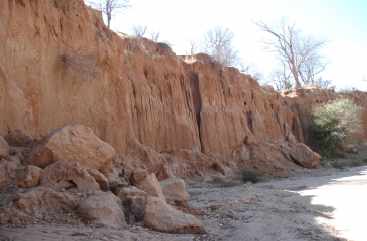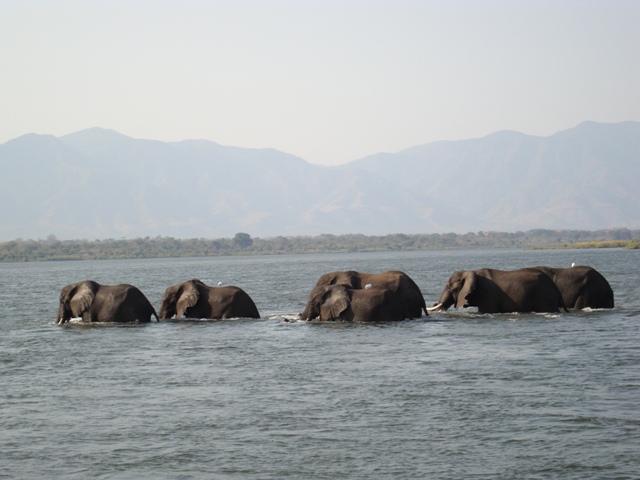 |
 |
Chapter 5 · Northern Mix
Zimbabwe & Botswana Fossils
The Far North

Sapi River in the Zambezi Valley. Dinosaur fossils have been found in river banks in this area |
In the Northern part of Zimbabwe near Kariba, dinosaur fossils have been found in an area with fossil plants, non-marine molluscs and fossil wood. It seems this particular area had habitats similar to some parts of the present Congo. There were probably lakes and forests, with many plants supplying food for the large herbivores. The fossil plants found in the northern part of the country would indicate a more forested or well-watered environment. There is plenty of fossilised wood in the Zambezi valley. Many of the plants found in Zimbabwe’s fossil deposits are now extinct. The Madumabisa shales of the Zambezi valley have evidence of the presence of cycads or conifers. |
Near Hwange
Glossopteris and Gangamopteris floras have been found. They are some
of the common plants found in Southern African coal formations. Near
Chirundu fossil wood of the genus dadoxylon was found. Dadoxylon
trees were tall and possibly formed big forests in this area. The floral
assemblage of dadoxylon and various ferns is typical of a wet climate,
and would have suited large sauropods. In some areas of the Zambezi
valley we have heavier woody trees in lower sedimentary rocks and
lighter ferns in higher sedimentary rocks. This shows the affects of
gravity on the fossils while they were being deposited by water.
Dinosaurs
There have been a number of dinosaur remains found in the northern
part of Zimbabwe. At least 20 dinocephalians died at the same site in
the Binga district, showing how they collected into a herd before
drowning. An interesting fossil site was found on an island on Lake
Kariba. Here the bones of a large sauropod dinosaur were found in
water laid down sandstone. It is interesting that the dinosaur was found sandwiched between lava
flows, showing the basalt was being deposited as the flood was in
progress.
Fossil Wood
Fossil wood is found in various localities in Zimbabwe with a good fossil forest in Hwange National Park. At Deteema Pan a single tree trunk was 1.2 metre thick at the base and at least 18m in length. At the other end the tree has a 0.3 metre diameter. The preservation of the wood varies with some being in excellent condition while others have become structureless masses of silica. Some have bark while one had what appeared to be insect borings. Stumps with roots still in the ground in Zimbabwe are rare, but there is an example at the Charama plateau. Some of the Zimbabwe fossilised woods were silicified in their positions of growth or seem to have been transported by water before silification.
 |
The preservation of bark on some specimens, its absence in others, and the apparently rotten interiors of some logs, seem to show the onset of silicification varied from almost immediately after the death of the tree, to some time later. This meant that rotting did start in some specimens, but silification prevented complete rotting. The early date for alteration is supported by the fact that most logs are uncrushed, almost circular in cross section and have radial shrinkage cracks filled with amorphous silica. The alteration cannot then have taken place under deep earth sediments, but seems to have taken place in water. When Lake Kariba filled with water in the early 1960’s; many Mopane trees drowned in the lake and were left standing in the water. These trees have shown that many trees resist decay under warm freshwater for many years. In Noah’s Flood the silification of the fossil trees took place after the floodwaters covered them. Chemical changes took place in the water changing the original tissues to silica. The sediments in which these logs are now deposited show it was not an ordinary lake in which these fossils formed. Fossil trees in this region have growth rings, showing seasonal variations and that the region was well watered and the trees healthy before the flood. |
Dinosaurs & Mammals Together
The Nyamandlovu area just north of Bulawayo has some flood sites that produced both dinosaurs and mammals. The four sites where this is the case, are named Southcote, Chelmer Spruit, Spring Grange Farm and Dovenby ranch.
Chelmer Spruit produced a sauropod, large equid (horse/zebra), pig, hippo, tragelaphus (eland/kudu), large buffalo, gazelle, large wildebeest and large hartebeest.
Spring Grange farm produced a sauropod, dinosaur tracks and an equid (horse/zebra).
Dovenby ranch produced an unidentified dinosaur, equid (horse/zebra) and buffalo.
Southcote had two types of dinosaurs, these being the syntarsus and a sauropod, and an equid (zebra/horse).
This site yielded about 22 partial sauropod dinosaur skeletons from sandstone. These specimens show the limbs being dismembered while the flesh was still on them showing a rapid burial. Some bones were crushed and this is evidence of there being some violence in the destruction of these creatures. The syntarsus was found in good condition with perfect articulation, the bones looking fresh and lacked the cracked and baked appearance of bones that lie on the surface. It appears that this creature was deposited quickly. It even had the remains of an unidentified creature in its stomach.
This shows dinosaurs lived with buffaloes, hippos and other animals before the flood. The dinosaurs found in this area seem to be limited to two species, although more may be found later.
The two dinosaurs present included the huge vegetarian Sauropods and a smaller carnivorous dinosaur called Syntarsus. Unfortunately some of the mammal and dinosaur remains from this area have not been studied properly and the documentation has been poor. There has been very little collecting in the last 40 years in the Nyamandhlovu district and many fossils await discovery.
Both the dinosaurs and mammals were found in sandstone or calcareous material. The evolutionary view is that even if you find these creatures together then somehow there must have been some later mixing of the mammals. The Nyamandlovu mammal deposits are conveniently labelled as alluvial deposits, even though they come from identical rocks to the dinosaurs and often in the same locality. These fossils are not dated by any scientific method - rather they are used to date the rocks in which they lie. As a result the rocks with mammals in are classified as younger than similar dinosaur bearing rocks. It is a well-known fact that fossils are used to date rocks in Southern Africa and elsewhere.
The public has been brainwashed into believing a myth,
which is that carbon dating or some other dating method shows fossils
are from a particular age. This is how evolutionary logic works – if the
fossil looks old then so the rock must be old. An appropriate date is
found based on how old the fossil must be according to an evolutionary
(theoretical) time scale and voila you have a date for the fossil and rock.
Now if you find a fossil down the road in a similar rock formation, then
the fossil is judged to be of the same age as the first fossil by looking at
the rock type. If a fossil is found in this same rock type, from a different
‘evolutionary’ age, then this rock type will be given a different age –
even though it is identical to the first rocks mentioned. This shows that
circular reasoning is used, based on a theory about the past and this is
not good science. With other fossil sites in Southern Africa we can now
see that dinosaurs, mammals, Australopithecus and humans all lived at
the same time.
Redcliff
In Zimbabwe the Redcliff limestone deposits held many different
fossils. One section of the limestone was rich in bones to a depth of
roughly 10 meters. Apart from the mammal bones found, there were the
remains of an ostrich, tortoise, snakes and a monitor lizard. Smaller
remains of shrews, rodents and bats were found. This site appears to be
a flood deposit and many of the Zimbabwe limestone formations may
also contain an abundance of fossils.
Orapa
The Orapa diamond mine of Botswana appears to be a volcano that erupted as flooding took place. It has been extensively studied and yielded a unique assemblage of fossils, which include flowering plants, and whole-bodied insects. These were found in sediments within a crater and were deposited rapidly in mass flows. The collections from the site number almost 6000 macrofossils of which 44% are plant remains and 51% insects. The formation of the crater took place in watery conditions. The folding, slumping, faulting and catastrophic nature of much of the deposits indicates highly unstable conditions.
About 50 to 100m of sediment may have been eroded from the top of the pipe. Some of the shales in the deposits had rain-pitted surfaces. One rain-pitted surface was found to be rich in evaporite crystals and insect remains, many of which were complete and had wings outstretched. The latter may have been accumulated through wave action. There were also mud cracks and evaporite on one of the rain pitted surfaces, which may indicate there were temporary stops in the 40-day 40-night rainfall or a drying by the volcanic activity. The sedimentary deposits at Orapa formed quickly and cockroaches that were found here were buried rapidly. Of the insect fossils found, some are now extinct but many are still found today in the region.
The presence of plant eating insects and insects requiring decaying
organic matter at some time in their life cycle, suggests a continuous
vegetation cover. Other insects indicate a seasonal, forested
environment with high humidity and close proximity to water.
Relatives of almost all the identified insects found in the deposit favour
wet forest habitats today. Leaves found at the site are from deciduous
plants, showing that there was a seasonal climate. 29 leaf types are
described. The plants are different from those now found in the area.
One of these plants may be placed in an existing genus. Ferns, flowering
plants, fruits and seeds were found. The flowers show both wind and
insect pollination. Plant groups included Pteridophytes and
angiosperms. Some charcoal shows the volcanic activity may have
burnt some of the plants. The leaves of the plants were mostly small,
which shows there may have been cool temperatures or a wet montane
climate. Entire margined leaves show a warm temperate and moist
climate. We can say the climate here was temperate, seasonal and wet
and the surrounding area was forested. This vegetation would probably
have suited the fossil assemblages found around Bulawayo and
Nyamandlovu.
What It Was Like
The grazing mammals and dinosaurs such as the Sauropods show that
parts of Zimbabwe were fairly open or well forested. There were
probably lots of forested areas over Botswana and Zimbabwe, with lush
woodlands and some higher ground. The animals found attest to there
being some rocky terrain, open country and woodland. The lowland
glossopteris forests may have been very thick and particularly suitable
to large plant eating dinosaurs.

| << PREV |
|